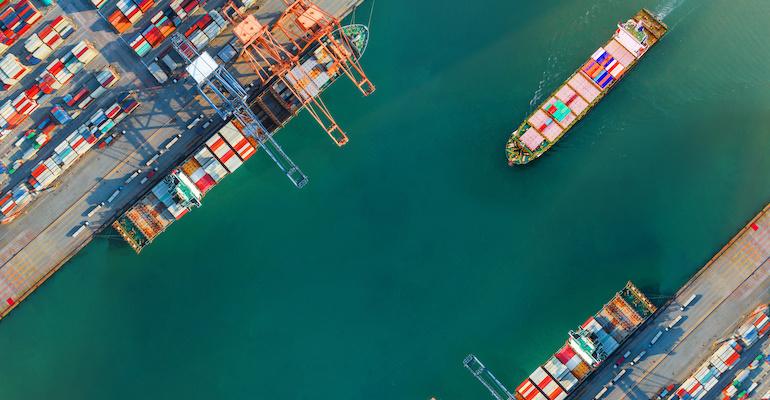Barbara Troner, from S&P Global began the session with an overview possible future uptake of ammonia, methanol, hydrogen, LNG and biofuels. In Troner’s forecasting slides, she explained that alternative fuels would likely not see big gains prior to 2030; indeed, scrubbers would keep up demand for heavy fuel through the end of the decade- with “the lack of feasible alternatives….the demand for high sulphur fuel is not going to go away,” she said.
Through 2030, S&P is predicting that LNG would be the dominant “alternative” fuel option, with tankers and containerships leading the uptake. Her presentation also touched on price impacts of the upcoming European Union Emission Trading Scheme (EU ETS) on specific tanker trades, suggesting that increases in freighting costs on affected moves into/ out of EU ports, circa $0.30- $0.40 per barrel, would have a significant impact on crude oil arbitrage differentials.
Toby Menzies, from Core Power, Nuclear for Maritime, who had given a brief presentation following Troner, pointed to a topic highlighted in a previous session- the “Green energy gap”, which he believed is being ignored. On the “blind spot” question, he asserted that: “Scaling up green shipping requires massive generating capacity.”
The main morning panel, “The Accountability Framework for the Energy Transition”, drilled down into the practicalities of how the transition might be administered, at the micro level within companies, and, more broadly, throughout the vast international trade sphere. Superb moderation by Carleen Lyden-Walker, at the helm of North American Marine Environmental Protection Association (NAMEPA) drew out responses from panel members on how the transition might be better managed.
Measursing the transition
Panel member Jan Hagen Andersen, Business Development Manager at DNV Maritime, emphasized a difference with dictates concerning new fuels, compared to previous regulatory mandates and the commercial impact. “We talk to commercial people as well as technical people at our clients,” he said. Taking a very practical slant, he added that: “We do have the tools to measure different ways you can measure fuel consumption, and verification is also becoming critical…there are a lot of innovative solutions such as sensors.”
Panelist Elpi Petraki, representing the Greek shortsea sector, opined that with the Carbon Intensity Indicators (CII) rules now coming into force, “for the first time, we can have a real discussion between owners and charterers, and discuss real numbers.”
Fellow panel member Helio Vicente, from the International Chamber of Shipping (ICS), said that: “This year is a pivotal year in developments we will have in decarbonisation. Accountability and transparency frameworks will be put in place,” but he expressed a concern as to how these measurements actually work.
In looking across the alphabet soup of possible metrics under consideration, he said: “EEOI potentially a more fair and balanced metric – it looks at cargo carried. Responding to a question regarding blind spots and what’s missing, he suggested that a broader conversation among all participants in the value chain, regarding clean energy hubs, is what’s needed.”
Difficulties with data
Jennifer States, newly appointed Chief Strategy Officer at the Blue Sky Maritime Coalition, that is working with North American shipowners on decarbonisation, highlighted a present “gap in knowledge” and extensive difficulties with data on vessel emissions. She explained that, presently, most North American ship operators are not required to report under the present IMO dictates, but that: “Regulations are likely to come at some point”. She emphasized that: “We have an opportunity now to get it right,” and to look at the feasibility of employing different measurements, and to “come up with a way to make the measures work for multiple parties.”
She voiced the view that shipowners ought to be trying to get out in front of regulations, and highlighted the practicalities, where solutions are under development, saying: “Yes we can measure fuel consumption, but there are large discrepancies depending on the fuels.” She highlighted the efforts of Sailplan- now providing direct measurements for US. OSV operators Harvey Gulf, and Hornbeck, in the US Gulf.
Moving over to the high cost of installing measurement technologies, States stressed the need for public sector governmental funding to deal with these high prices and to figure out pathways through demonstration projects- the “Key gap is in financing,” she said. An example cited was the Norwegian governmental involvement in the electrification of ferries.
Arlie Sterling, from consultancy Marsoft Inc., also involved with the Blue Sky Maritime Coalition, said flatly that: “Measures like CII and AER are not very meaningful,” in that they inevitability conflate concerns of owner – the quality of vessel, with those of the charterer - user of the ship.
He emphasized Marsoft efforts with shipowners towards financing vessel retrofits which break out the economic implications very specifically. He talked about life cycle calculations of emissions reduction as being “very much open” a long way from measurement. On the questions of carbon capture and sequestration, which come up as alternatives to full decarbonization, he described their measurement being “an unsettled issue.” Long term charter arrangements, where charterers could help pay for alternative fuels, is something supported by Dr. Sterling, along with other panel members.
At such presentations, sometimes the best observations come from the audience- during the Q&A session. Audience member Harry Theochari, OBE, a noted UK lawyer and the Chair of Maritime London, asserted that: “The way forward for maritime decarbonisation is “as clear as mud”. Among his other observations, getting beyond the practicalities of measurements, were “Shipowners charterers don’t make any effort…unless they are forced to”. Expressing concern about the IMO’s upcoming MEPC 80 meetings (in Summer, 2023), he said, “Regulators need to get their act together.”
Copyright © 2024. All rights reserved. Seatrade, a trading name of Informa Markets (UK) Limited.
Add Seatrade Maritime News to your Google News feed.  |

